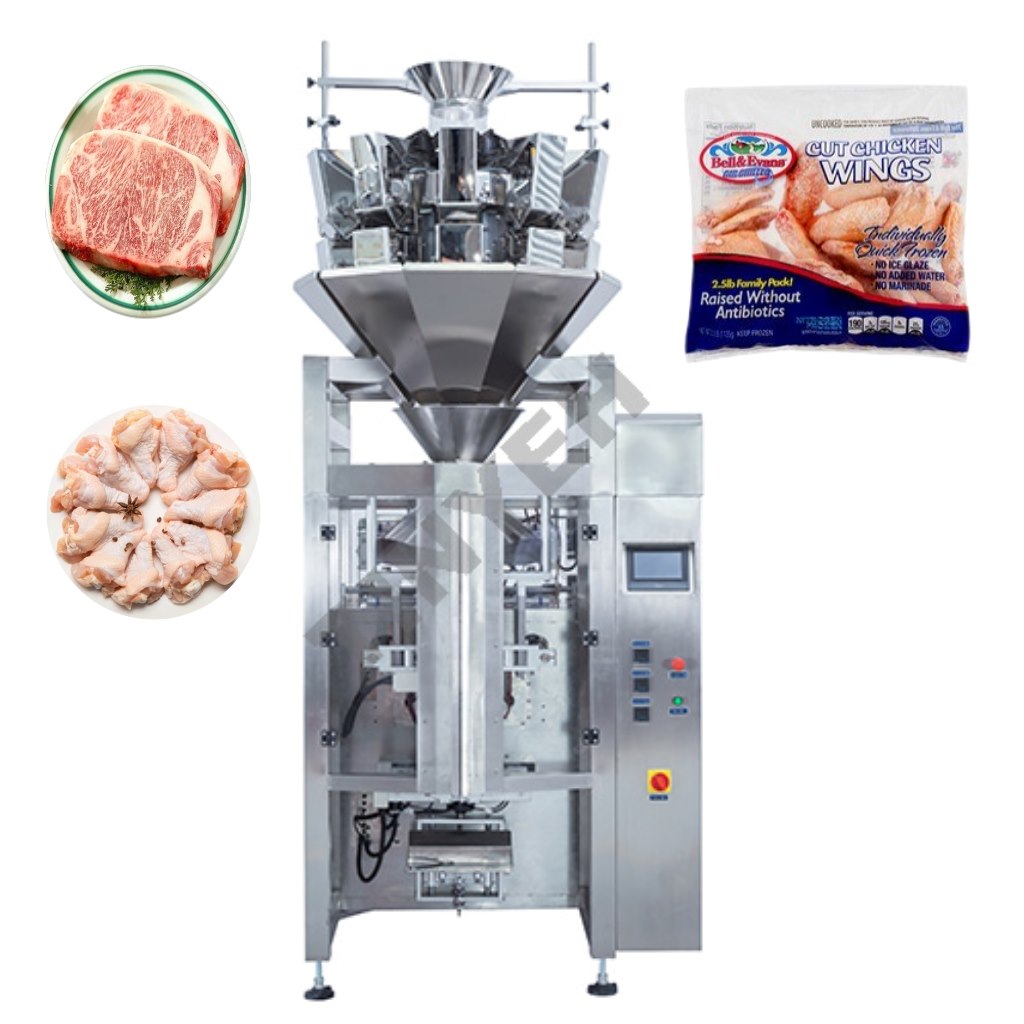Frozen food packaging plays a vital role in ensuring the safety, quality, and longevity of frozen products. Unlike general food items, frozen foods require specific care during packaging to preserve their texture, flavor, and freshness. To meet these unique needs, frozen food packing machines are designed with specialized features. Here we’ll explore the key characteristics of these machines and why they are essential for handling frozen food.
Tinyeh Frozen Food Packing Machine
1. Temperature Control and Insulation
Frozen foods must remain at low temperatures from production until they reach the consumer. Any increase in temperature can lead to thawing, which compromises product quality. Frozen food packing machines are built to maintain cold environments, with features like insulated chambers and refrigeration systems that keep products frozen throughout the packaging process.
These machines are designed to operate efficiently in low-temperature settings, preventing thawing or freezer burn. On the other hand, general food packing machines are not equipped for such cold conditions, making them unsuitable for frozen products.
2. Gentle Handling for Delicate Products
Frozen food items like vegetables, fruits, and meats can be fragile. They are prone to damage if handled roughly during the packing process. Frozen food packing machines are engineered to gently handle delicate items, ensuring they retain their shape and texture. Soft conveyors, adjustable feeding systems, and sensors are incorporated into these machines to minimize impact on fragile products.
This careful handling prevents crushing or deforming frozen goods, ensuring that products maintain their visual appeal and overall quality. General food packing machines, however, are not designed for such delicate handling and may result in damaged products if used for frozen foods.
3. Specialized Packaging Materials
Frozen food packaging needs to be more durable than packaging for ambient temperature products. It must be resistant to moisture, air, and cold temperatures. Packaging materials used for frozen foods include high-barrier films, laminated plastics, and foil-based materials, which provide an airtight seal to prevent freezer burn and preserve freshness.
Frozen food packing machines are designed to work with these specialized materials. They ensure proper sealing and maintain the necessary barriers to protect frozen products during storage and transportation. General food packing machines, however, are not typically designed for these specific materials and may fail to create the necessary airtight seals for frozen goods.
4. Advanced Sealing Technology
A strong seal is essential for maintaining the quality of frozen foods. Improper sealing can lead to contamination, freezer burn, and loss of product integrity. Frozen food packing machines are equipped with advanced sealing technologies, such as vacuum sealing and heat sealing, to ensure a tight, airproof seal.
Some machines even use Modified Atmosphere Packaging (MAP), which replaces the air inside the package with a protective gas mix, extending the shelf life of frozen items. These specialized sealing methods are critical for frozen food packaging. General food packing machines typically use basic heat seals, which are not suitable for the more demanding conditions required for frozen products.
5. Speed and Efficiency
The frozen food industry requires high-speed production to meet consumer demand. Frozen food packing machines are designed for efficiency, allowing large volumes of products to be packaged quickly without compromising quality. These machines are optimized for continuous, high-volume operations in cold environments.
They use automated systems for feeding, weighing, and sealing, which ensures a streamlined process that doesn’t slow down the production line. While general food packing machines are still efficient, they are not designed for the rapid packaging of frozen foods and may lack the features required to operate in cold conditions.
6. Customization for Various Frozen Foods
Frozen food packaging can vary depending on the product. Whether it's frozen vegetables, seafood, or prepared meals, each item may require different handling, packaging materials, and sealing techniques. Frozen food packing machines are versatile and can be customized to accommodate various frozen food types. Adjustments can be made to temperature settings, conveyor speeds, and packaging formats to meet the specific requirements of each product.
General food packing machines, however, are designed to handle a broader range of products but lack the customization features needed for the specific demands of frozen foods.
Why Specialized Machines Are Necessary for Frozen Foods?
Frozen foods face unique challenges that general food items do not. Maintaining the frozen state during packaging, ensuring gentle handling to prevent damage, using specialized packaging materials, and employing advanced sealing technologies are all critical factors in preserving the quality of frozen products. Frozen food packing machines are designed to meet these needs, ensuring that products are packaged efficiently and safely.
Without specialized machines, manufacturers risk compromising the quality of their products. General food packing machines simply cannot offer the temperature control, delicate handling, or sealing technologies required for frozen foods.
Conclusion
Frozen food packing machines are essential for ensuring that frozen products reach consumers in optimal condition. Their specialized features—temperature control, gentle handling, compatibility with specialized packaging materials, advanced sealing technologies, and speed—address the specific needs of frozen foods. Investing in these machines helps maintain product quality, extends shelf life, and meets consumer expectations.










